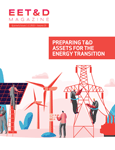
It’s a little over a quarter of the way through 2022, and we’ve hit another COVID-19 milestone. After all, it was two years ago that most of us experienced some sort of mandated shutdown. For the magazine, it was also when our contributing writers first mentioned COVID-19. Since then, no one profession or industry has escaped at least some disruption due to the pandemic. And our magazine is no exception. To get back on track with our publishing schedule, we decided to combine our 2022 Q1 and Q2 issues, making it possible to print a more robust issue in time for a bonus distribution at both IEEE PES T&D and DistribuTECH events.
Over the past two years, contributors to EET&D have shared their experiences, concerns and suggestions to get us through what I hope is the worst of the pandemic. As the topics covered in this issue seem to indicate, we are now at the stage of the pandemic where we are assessing the physical, financial and psychological damages, while figuring out how best to prepare for what comes next.
In his article “America's Power Grid is at Risk. We Have the Tools to Fix It — But We Need the Will” Desmond Wheatley with clean technology company Beam Global talks about how the February 2021 power outage in Texas, and the hackers who shut down the Colonial Pipeline U.S. last May exposed the U.S. power grid’s vulnerability. He also points to the aging infrastructure’s inability to keep pace with the growing demand for energy as a key reason for this vulnerability. Wheatley believes we have innovative solutions like microgrids that can lessen the burden on aging infrastructure and help wean energy consumers of their dependency on fossil fuels, but it is the “will of the public and private sectors to boost our energy resiliency and transform how this country runs.”
Fortunately, with the passage of the 2021 Infrastructure and Jobs Act, more than $65 billion will go towards enhancing grid reliability and resilience, building and upgrading transmission lines, improving grid flexibility with demand response and distributed energy resources and boosting cybersecurity. It also will fund new programs to support the development and deployment of clean energy technologies to accelerate our transition from greenhouse gas emissions to a zero-emission economy.
And while the funding from the infrastructure bill will have a positive impact on the electric energy sector, CEO of DIREXYON Technology Didem Cataloglu cautions us that there are many steps involved to make the shift to truly clean energy, starting with recognizing that electric energy is not always synonymous with clean energy.
As she discusses in our Powherful Forces profile on Cataloglu, when talking about the transition to clean energy, people often use the words 'clean' and 'electric' interchangeably. “But when you purchase an electric vehicle, it may not be entirely ‘clean,’ because the electricity may have been produced from fossil fuels – in which case, it may not be decreasing your overall carbon footprint to its fullest potential,” says Cataloglu. She also offers steps to consider that will help pave the way for clean energy. You can read more of Cataloglu’s insights on page 80.
In this issue’s Grid Transformation Forum, we asked Dr. Andrew Phillips, vice president of Transmission and Distribution Infrastructure for EPRI, to talk about the future of T&D infrastructure in the global transition from greenhouse gas emissions.
According to Phillips, utilities are figuring out how they can leverage existing assets to meet the Biden Administration’s greenhouse gas emissions goals by 2030. He elaborates, saying, “Research from the Electric Power Research Institute (EPRI) shows that leveraging the existing energy infrastructure — including hydropower, nuclear and transmission assets — is a realistic option to provide low-cost carbon reductions.
Referencing findings based on research conducted by EPRI, Phillips identifies the challenges utilities looking to leverage their existing infrastructure may face, and steps they can take to address them.
The pandemic may stick around for a while yet, and the infrastructure bill will not magically remove any potential disasters that aging utility infrastructure could cause, but the past two years have shown us that by optimizing existing and investing in new infrastructure, while having emergency response protocols already in place, utility providers and consumers stand a significantly better chance of surviving a global energy crisis than we did two years ago.
On a lighter note, we are pleased that Wayne Bishop Jr., who is the IEEE PES vice president of meetings and conferences, graciously agreed to provide a preview of is year’s event in New Orleans. Some may be reading this issue after the IEEE PES 2022 conference has ended, but Bishop’s detail gives anyone who missed the event a sense of the topics and issues the conference covered. If you are among those who weren’t able to experience the opportunity to reconnect with industry colleagues in real life or catch up on the latest technology during IEEE PES, Bishop has agreed to share a recap of the event in our Q3 issue.
If you would like to contribute an article or if you have an idea about interesting technology, solutions, or suggestions, please email me at: Elisabeth@ElectricEnergyOnline.com
Elisabeth







